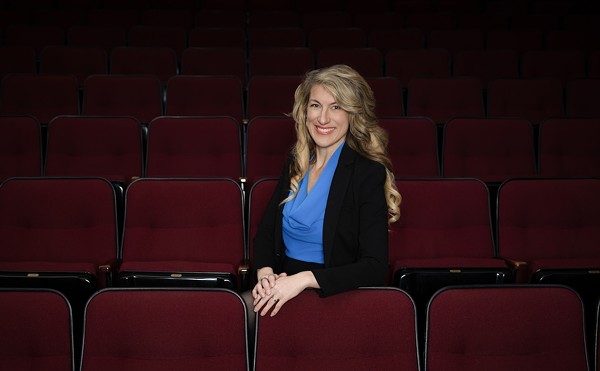This isn't one of those days though: It's muggy St. Louis, and the cyclone fencing, the empty lot (among the other empty lots), the unpeopled city -- all suggest the pejoratives: closed, bunker, exclusionary, a pricey gewgaw with a designer name (Tadao Ando), the architecture there merely to distinguish the wealthy patron's collection (Emily Pulitzer) like exquisite wrapping paper. The distinctions this city would prefer to avoid discussing -- class, race, privilege -- weigh the building down on approach. The Pulitzer Foundation for the Arts is, as its name says, for the arts -- but for whom?
The security guard scuffles around, smokes his cigarette near the entryway (later he's out behind the building, just looking up at it, caught in marvelous attention to a flat, concrete surface). The building gives its first opening -- a small courtyard with a female figure by the sculptor Aristide Maillol -- leading to a glass doorway and the entrance, today a little cluttered with docents and guestbooks and visitors huddling and whispering.
Inside the Pulitzer Foundation, the misgivings felt outside are immediately dissolved by the elegance of the space. Ando's buildings can easily be compared to bunkers (I've done it), but the metaphor dissolves once the visitor is inside. Elizabeth Taylor, or Warhol's version of her, winks at you in the corner. Two dazzling Monet water lilies contribute liquid, light and color to the concrete surroundings. A Kiki Smith sculpture -- a female figure with yellow beads streaming from her -- abruptly shifts the mood.
A grand hall gives space and light that works by Andy Warhol, Roy Lichtenstein and Philip Guston deserve. Airy furniture constructed of latticed metal -- like the kind of overstuffed chairs Lichtenstein painted in his interior landscapes -- is unexpectedly comfortable, ideal for sitting and appreciating a monochromatic painting by Ellsworth Kelly. Another Kelly, designed specifically for the end of the hallway -- a long, thin blue-and-black rectangle -- changes with the day under a slender skylight. One of the docents hovering about the room for the opening preview uses the loaded word "perfection" in describing the effect, but damned if she isn't right.
The "perfect" Kelly leads to a cascade of stairs and -- in one of the many jaw-dropping moments the Pulitzer provides -- a complete series of 10 Jasper Johns prints with numerals 1-10 functioning as the central iconographic image in sequence. Lush, inked in a rich, earthy brown, with Johns' playful use of line and clever visual allusion -- Mona Lisa smirks by the No. 7 -- consolidated as they are on one wall, they invite dual reflections (Ando's inclusion of a pond adjacent to the grand hall makes reflection a theme -- the water lilies are even more evocative, as if that were possible, by the real water outside the windows nearby). One: the virtuosity of the work, the complete portfolio making for a Johns miniretrospective. Two: The whole portfolio actually belongs to someone, as do all the works here. Joe and Emily Pulitzer collected this work, paid for it; it's hers. The curatorial eye of this pair (Joe, who had the acumen to buy a Modigliani when he was 23; Emily, a dynamic curator at the St. Louis Art Museum for 10 years) astounds, but at least as remarkable is the estimation of the wealth that allowed them to possess what their eyes adored. That great collections are created by great wealth is a given; nonetheless, a common citizen engaged with these private possessions cannot deny the power inherent in such ownership. Money is the static that disturbs contemplation -- or intensifies it.
Just as the exterior of the building invites consideration of issues not to be discussed in polite conversation, the treasures inside provoke an evaluation of privilege and its relationship to art, the artist, value, the benevolence of the patron who allows access to the exquisite things she owns, the irritant of class: Only with such benevolence is the common citizen allowed a view. Isn't it a duty of the receiver to bite the hand that gives?
Such thoughts slip away when the visitor enters one of the Pulitzer's alcoves, a room of mostly cubist work by Pablo Picasso, Georges Braque and Juan Gris (and a curious work of marble by Alberto Giacometti in one corner). As the visitor moves from the light of the hall and stairwell into the more intimate, subtly lighted room, a Picasso portrait of a woman in a yellow dress from 1907 first draws the eye. The sumptuous, daring composition is testimony to why Picasso became Picasso. Smaller paintings and collages on the walls adjacent and opposite compel the viewer to get closer. In the standard museum slide-show installation, such works get lost. Here, with the noise of the pop art silenced -- and those peevish questions distracted -- cubism is removed from the art-historical context, and what becomes wholly present is its sensual magic. Cubism, as realized in this installation, was not just a new way of perceiving -- a vision necessitated by the incursions of the modern world -- but a new way of loving that Tworld. A Picasso collage becomes precious in the manner of a Cezanne still-life in this space.
Upstairs, another alcove creates a similar intimate visual theater. A black Richard Serra painting on canvas takes up a corner of the room, and two paintings by Mark Rothko -- one light, the other dark -- are alone in the space with a wooden bench, featuring an intriguing cross-grain design by Ando, in the center. In this space, the darker Rothko presents a stunning visual display, one that rarely occurs in the traditional museum or gallery environment. The painting takes time to see, for the eyes to adjust to the light so that the colors begin to emerge, begin to glow, and the edges of Rothko's shapes begin to shimmer. As one leaves the room and returns to the grand hall and the nearby pond, the building has changed again, the inner rooms transforming the outer -- as the mind's inner vision transforms things seen.
The Pulitzer's library contains a Picasso that's a bit too loud -- because of its wild exuberance and because it's a Picasso -- for concentrated study. Outside a rectangular window is a glimpse of the Serra sculpture "Joe," a bit ominous in the rectilinear frame, like a Neal Jenny painting. Next door is office space -- the two most curious items being a small portrait of Joseph Pulitzer by Lucian Freud (a friend found this the most moving work in the foundation) and a really cool private shower room. Ando does not do so well with other bathroom facilities. One major design flaw is the window by one women's public toilet -- great for looking out but a bit of an embarrassment when looking in. Maybe there's a thin little curtain to go with the thin little window that hasn't yet been installed.
An exterior courtyard, which will be shared with the Forum for Contemporary Art after its building is completed in 2003, holds the Serra as centerpiece. A monumental work of torqued Cor-Ten steel, "Joe," in honor of the late publisher, counters the concrete squareness of the Ando with tarnished disequilibrium. The walls of the spiral structure lean in, lean out, curve, bend, bow -- effecting a roller-coaster ride without the viewer's leaving the ground. At the center, the sky above has drunk too much.
Leaving the spiral woozily, leaving the building -- again the viewer finds the way out has changed the way in. Who is the Pulitzer Foundation for? Laurie Stein, who has left her World War II/Holocaust-provenance research for the St. Louis Art Museum to direct the foundation, says it's for everybody, even children: "We never said it wasn't for children. I don't know where that idea came from." The two-day-a-week, by-appointment-only restrictions are less limitations to the public (really, how many locals are dying to see this collection?) as they are preserving an engagement with art that is unlike the common museum or gallery experience. During a post-tour phone conversation, Stein earnestly asks how the experience was, talks about how the staff is exploring ways to enhance the individualized experience in the public space -- a space where the notion of public and private is being redefined.
In the aftermath of the enormous tragedy, the Ando makes for another sober, unintended reflection: Is the bunker now a metaphor for the preservation of civilization itself?





